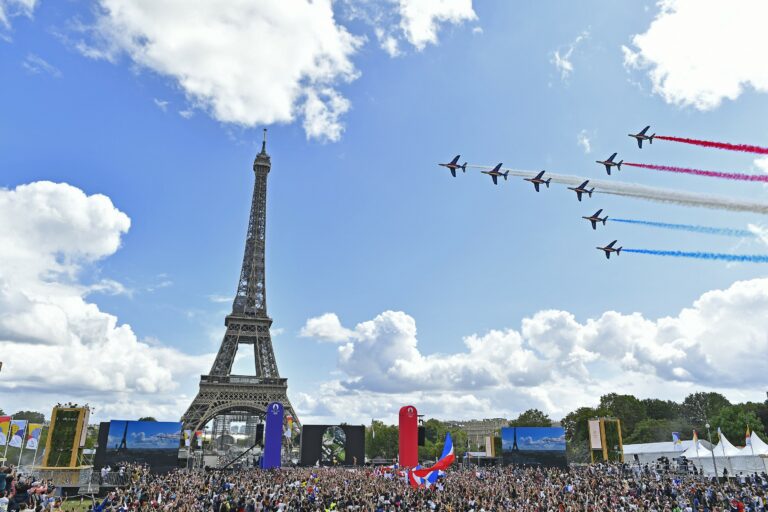When the Olympic Games opened last week in Paris, France, they did so with the promise they would be the greenest in history.
Among other things, organizers say the games will run entirely on renewable energy, feature mostly locally grown food and cut-down on the massive amount of single-use plastic that plagued previous Olympics.
Observers say the games will be a litmus test for whether the world’s biggest sporting events, which have been criticized for their impact on the environment, can truly deliver on promises to be more sustainable.
“With the right planning, major sports events like the Olympics and Football World Cup can serve as a shining example of how humanity can live in harmony with nature,” said Susan Gardner, the director of the Ecosystems Division of the United Nations Environment Programme (UNEP).
We recently spoke with Gardner, who serves on the International Olympic Committee’s Sustainability and Legacy Committee, about how sports can help to counter the rapid decline of the natural world. Here are excerpts from that conversation.
These Olympics are the first since the International Olympic Committee joined the UNEP-supported Sports for Nature initiative. Launched in 2022, the effort provides a game plan for sports at all levels to become better stewards of nature. Why is that important?
Susan Gardner (SG): Right now, human activities are putting ecosystems under enormous pressure, with a growing number of species facing the prospect of extinction from the impacts of nature loss, climate change and pollution.
Ending this crisis will take a concerted effort from many big actors, like governments and businesses. But sports federations have a role to play, too. At a minimum, they have an obligation to do no harm to the environment. At their best they can help inspire a new movement for nature, and encourage their billions of followers to protect and restore the planet.
How exactly can sports help counter the nature crisis?
SG: Sport for Nature has a simple, four-point plan that focuses on conserving nature, restoring what has been lost, reducing the drawdown on nature through more sustainable procurement, and inspiring players and fans to get involved.
It does these things in a combination of ways, including by providing sports with resources, and hosting events and webinars.
Are sports becoming more sustainable?
SG: Sustainability is becoming increasingly important for sports. But still, sustainability departments are often lightly resourced and over-tasked, meaning that while progress is being made, the pace is slower than many would like.
That said, many sports federations have begun to take concrete steps to lighten their footprint on nature. A prime example is the International Olympic Committee, which has developed a plan to embed sustainability into the Olympics and provide lasting benefits to host countries and their citizens.
That’s already manifesting itself this year. In Paris, civic officials have launched a US$1.5 billion effort to clean and restore the Seine River, which had been unswimmable for more than 50 years.
Another example is World Rugby. It has developed a 10-point plan for delivering for nature, which is being shared with clubs across Europe and the Pacific.
Finally, the Sport for Climate Action movement, supported by the UN Framework Convention on Climate Change, has helped many sports reduce their greenhouse gas emissions and reached impressive outcomes.
What impact has Sport for Nature had so far?
SG: It is a young initiative, so while we can’t judge it yet, it is making progress and has 62 signatories. Many are taking action to support the Biodiversity Plan, a landmark global accord to protect and restore the natural world.
Sport for Nature is a partnership between UNEP, the International Union for the Conservation of Nature, the International Olympic Committee and the Convention on Biological Diversity, with the support of Dona Bertarelli Philanthropy. This collaborative approach is working well but for many sports this is a new area which is not fully understood yet. We hope to change that in the coming months. Because with its incredible reach and influence, the sports world can showcase to the planet the importance of safeguarding our ecosystems.
What practical steps can sports organizations take to protect and restore nature?
SG: Sports depend on the ecosystems they play within but often in urban environments, nature has no home. It doesn’t have to be like that. Sports officials can incorporate natural elements into venues, such as green roofs and insect boxes, and design training grounds to provide habitats for native species.
When choosing venues for outdoor sports, like skiing, surfing and cycling, sports leaders can steer clear of ecologically sensitive areas. They can also ensure the landscapes they do use are protected.
“With its incredible reach and influence, the sports world can showcase to the planet the importance of safeguarding our ecosystems.”
The world is in the grip of a triple planetary crisis of climate change, nature and biodiversity loss, and pollution and waste. How is this affecting the sports world?
SG: In many ways. Extreme heat and air pollution, for example, are affecting the health of athletes and playing havoc with the scheduling of competitions. Climate change is leading to more extreme weather, with things like floods threatening sporting venues and other event-related infrastructure. These impacts will sadly only increase, with even more tragic consequences for climate-vulnerable communities, unless we act with urgency now.
Can nature help counter those threats?
SG: Yes. Nature can be a real ally in sustaining sports and allowing them to thrive. Planting trees around stadia, for example, can increase cooling. Restoring wetlands, which regulate the availability of water, can enhance resilience and prevent pitches from flooding. And cleaning rivers allows them once again to become sporting venues. In doing these things, the sports world can offer a template for how to protect and restore nature, and serve as a role model for governments, businesses and individuals everywhere.
The crisis confronting nature is urgent. We need everyone, including the sports world, to work together to safeguard our ecosystems.
Sports for Nature is a joint initiative of the International Union for Conservation of Nature, the International Olympic Committee, the United Nations Environment Programme, the Secretariat of the Convention on Biological Diversity and the Dona Bertarelli Philanthropy.
It aims to deliver transformative action for nature protection and restoration across sports, by 2030 and beyond. It provides a game plan for sports — at all levels — to accelerate and inspire others to take action for nature.
The planet is experiencing a dangerous decline in nature. One million species are threatened with extinction, soil health is declining and water sources are drying up. The Biodiversity Plan, formerly known as the Kunming-Montreal Global Biodiversity Framework, sets out global targets to halt and reverse nature loss by 2030. It was adopted by world leaders in December 2022. To address the drivers of the nature crisis, UNEP is working with partners to take action in landscapes and seascapes, transform our food systems, and close the finance gap for nature.
Read more: www.unep.org




